
|
Dark Noise and Hot Pixels in the Olympus E-300 |

|
My other articles related to the |
|
Noise is a phenomenon common in photography, digital or film. In film it is due to the fact that the photosensitive emulsion is not homogenous, consisting of crystals and clumps of crystals of silver halides which respond to the light. In digital it comes from the fact that the response of photosites to incident light has a random component. The basics of digital noise are explained in a short, separate article dedicated to the subject. I would recommend reading it so that you get more of this one. Here I'm dealing with camera noise visible at very long exposures, especially at high sensor gain (ISO settings). This is mostly the fixed (Type I) noise, where different pixels consistently show different response (as opposed to random, Type II, noise, where light sensitivity of the same pixel varies from one instance to another at the same pixel illumination). Measuring, or even qualitative evaluation, of the sensor noise is not simple, as many camera makers use algorithms which smooth out some of it (which also removes some of the legitimate image detail, depending on the particular algorithm). While the fixed noise reduction is usually explicitly activated by the user, the filtering of random noise is usually "built in", with the camera user having no say on how (and if) it is applied. This makes comparisons between cameras difficult. Generally, I believe that camera users and reviewers are paying too much attention to the noise issue. This is mostly (but not only) due to the fact that they view image samples under very revealing circumstances: on bright, high-contrast computer monitors, and in 1:1 pixel size (i.e., mapping every pixel of the image file into one screen pixel). This makes any noise much more visible than it will be in prints, even blown up to 30x40 cm (12x16"). Zoom in on the peachy cheeks of Miss America; if the magnification is large enough, this will be quite disgusting, too. The only applications where I start worrying about noise issues are low-light shooting. I mean very low light, exposures below one second. This also is why I'm more interested in Type I noise than in Type II. Here are some samples to show you how the E-300 performs in this area. My samples All image samples shown in this page have been taken from "lens cap shots", i.e. exposures in absence of any light reaching the CCD. The viewfinder eyepiece was also covered to avoid any stray light coming from that direction. Pictures were saved in the SHQ JPEG format, and the in-camera processing was set to contrast at -1, sharpness at -2, and saturation at +1. All fragments are taken from the same place in the original image (top-left x=1600, y=1200). To facilitate the comparison, images shown have been stretched in postprocessing: the 0-32 RGB brightness interval has been stretched to the full 0-255 range. In other words, the brightness of every pixel was increased eight times in the RGB scale. Without this, you would not be able to see any noise in some of the samples. |
|
Here is a comparison of a "straight" sample with the same bitmap after stretching. This is the highest noise the E-300 is capable of generating without going into bulb exposures: 30 seconds at ISO 400. Even here, in the worst-case scenario, the "straight" sample looks quite dark, except for some bright hot pixels (six or so in this sample), clearly visible in the full pixel size, plus more pixels of less brightness. Interestingly, most of the spots ale larger than just one pixel. This indicates either some image processing effects, or signal correlation between neighbors; possibly both. |
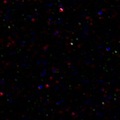
|
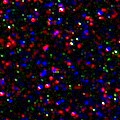
|
|
Straight sample: 30s, ISO 400 |
Stretched sample: 30s, ISO 400 |
|
I am including samples only for the "native" ISO settings of ISO 100, 200, and 400. The higher ones (800 and 1600) do not, most probably, change the CCD gain, being applied at the image processing stage only, by stretching the tonal range. You could do it, I suspect, equally well in postprocessing. The full sample set The array below contains stretched samples for exposure times from one to thirty seconds, and for all gain (ISO) settings. Exposures of less than one second are not worth a trouble, showing no dark noise worth mentioning. (This simply means: if you are not planning to shoot at one second or longer, just forget about fixed noise issues.) Note that the camera's NR option (subtractive fixed noise reduction) was not used in these samples. |
|
Reminder: all these are | ||||||
| ISO 100 |

|

|
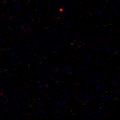
|
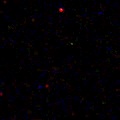
|
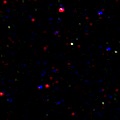
|

|
| 1s | 2s | 4s | 8s | 15s | 30s | |
| ISO 200 |
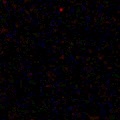
|
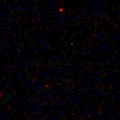
|
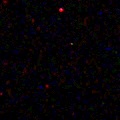
|
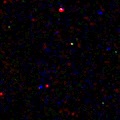
|
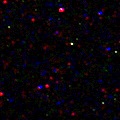
|
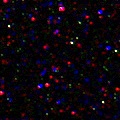
|
| 1s | 2s | 4s | 8s | 15s | 30s | |
| ISO 400 |
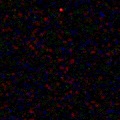
|
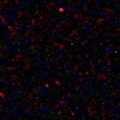
|
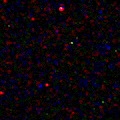
|
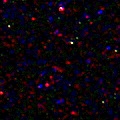
|
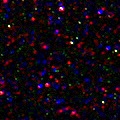
|

|
| 1s | 2s | 4s | 8s | 15s | 30s | |
|
Actually, after having done a similar analyses for a number of Olympus cameras, ranging from the C-3000Z to the C-5060WZ (with the E-10/E-20 in between), I was expecting similar results, just of different magnitude. This is why I considered this article to be a rather boring assignment, and I was postponing it as much as I could. It turned out not quite that way. First, the familiar. As expected, the noise visibly increases with exposure time and ISO setting. The increase is more significant in the latter case. One practical conclusion from this: at a given light level it is better to use low ISO with longer exposure than vice versa. Let us assume that your scene, shot at a given aperture, requires 8 seconds at ISO 100. You could, obviously, also use 4 seconds at ISO 200, or 2 seconds at ISO 400. A quick look at the samples shows that the first combination will give you the best results, noise-wise. As with other cameras, two components of the dark noise are visible in my samples: low-amplitude, more or less uniformly distributed one, and individual high-component spikes, hot pixels (or, due to photosite-to-pixel interpolation and electrical coupling between neighbors, groups of pixels). And here comes the first surprise: while the low-amplitude component is quite well under control (up to 30 seconds at ISO 100 and 200, up to 15 seconds at ISO 400, I would say), the incidence of hot pixels is higher than I would have expected, at least not in a recent-vintage camera. Just to not make you depend on small-area, stretched samples, here are two, presented at 1:1 pixel size, not stretched. I've chosen the 8-second exposure, as this is the longest one I have a need for (shooting fireworks). |
|
Note: these are | |
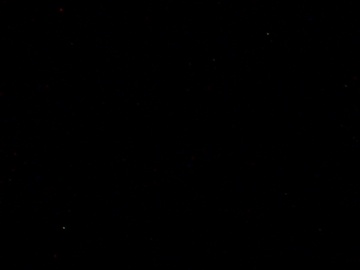
|
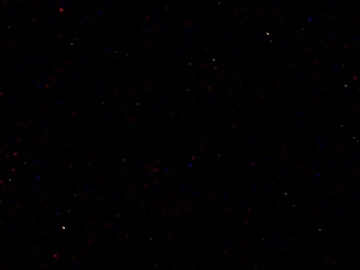
|
| ISO 100, 8 s, NR off | ISO 400, 8 s, NR off |
|
What can I say? Without noise reduction at ISO 100 you will have to do some clone brush work to remove the hot pixels (in my fireworks session I found that quite acceptable), but at ISO 400 this becomes excessive. Certainly, eight seconds at ISO 400 is no longer a useful combination, not without noise reduction enabled. (Actually, this looks much worse when you look at the full frame. If you are not afraid of a 5 MB download, here is one for 8 seconds, ISO 400. This looks like the opening screen in Star Wars. You do not want to clone-brush this one!) Fixed noise reduction Like many other camera makers, Olympus offers an option to activate fixed noise reduction. After having taken the actual picture, the camera records one more frame, this time with the shutter closed (no light on the CCD, very much like in my samples here), and subtracts it from the original one. This should take good care of the hot pixels (the high-amplitude component) at the expense of increasing the random noise amplitude (adding uncorrelated random effects from both exposures into the final result). Let us have a look on how this works in the E-300, at the noisiest ISO 400 gain. The matrix below shows samples without (top) and with (bottom) the NR feature enabled. |
|
| ||||||
| NR Off |

|

|

|

|

|

|
| ISO 400, 1s | ISO 400, 2s | ISO 400, 4s | ISO 400, 8s | ISO 400, 15s | ISO 400, 30s | |
| NR On |
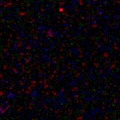
|
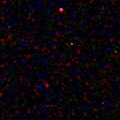
|
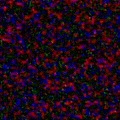
|
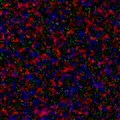
|
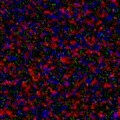
|
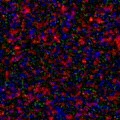
|
| ISO 400, 1s | ISO 400, 2s | ISO 400, 4s | ISO 400, 8s | ISO 400, 15s | ISO 400, 30s | |
|
First of all, it is clear that the camera ignores the NR setting at exposures shorter than four seconds: the two leftmost samples are identical between both rows. This was, obviously, introduced to stop users from applying noise reduction at exposure times when it may do more harm (random noise increase) than good (fixed noise reduction). It allows you to enable NR in camera settings and forget about it — it will be applied only when needed. (There is one problem with this: serial shooting mode remains inaccessible then!) While I essentially agree with this approach, I would, still, make it depend on the ISO setting. Based on my samples and field experience with the E-300, I would apply the NR at 4 seconds (ISO 100), 2 seconds (ISO 200), or one second (ISO 400). This is because I consider the random noise easier to live with than the hot pixel spikes. We can hope someone at Olympus will reach a similar conclusion and the firmware will be modified accordingly. Another surprise: the samples look very similar, if not identical, for all exposures where NR was applied. While the raised background in my stretched samples may look a bit high, it really isn't; remember the 8x factor! This is nice. Just to see what noise reduction does to exposures at lower ISO settings, here is a similar comparison for ISO 100. |
|
| ||||||
| NR Off |

|

|

|

|
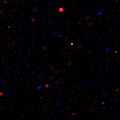
|

|
| ISO 100, 1s | ISO 100, 2s | ISO 100, 4s | ISO 100, 8s | ISO 100, 15s | ISO 100, 30s | |
| NR On |

|

|

|

|
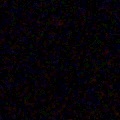
|

|
| ISO 100, 1s | ISO 100, 2s | ISO 100, 4s | ISO 100, 8s | ISO 100, 15s | ISO 100, 30s | |
|
Indeed, this looks just very good, with NR samples being, again, very similar in the whole 4-30 s range. And now I would agree with Olympus that 4 seconds is the right exposure to turn on the noise reduction at ISO 100. To conclude this section, let me show two larger, unstretched samples like those before, but this time with noise reduction on. To live dangerously (and to make a point), I've chosen the 30-second exposure, four times longer than before. |
|
Note: these are | |

|
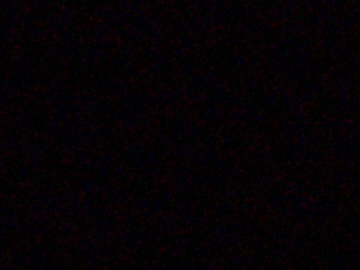
|
| ISO 100, 30 s. NR on | ISO 400, 30 s, NR on |
|
The Star Wars effect at ISO 400 is gone. This should be enough to show that noise reduction allows us easily to use exposure times of 30 seconds at ISO 400. Noise reduction does not come free. Because of the second, "dark" exposure, your next shot will be delayed by as long as the original exposure took. This is why in my fireworks session I decided against using this feature at ISO 100 and exposures of four and eight seconds, choosing rather to do some clone-brushing than losing a shot because of the extra 4-8 seconds of delay. Comparison with other Olympus cameras You may have a quick look at my older, similar reports on dark noise with the C-5050Z, C-5060WZ, E-10, and E-20. All use the same procedure of sample stretching, so the results are directly comparable. To have a closer look at the technology progress over three years, I decided to have a side-by-side look at the results from E-300 and the E-20, released almost exactly three years earlier. As I don't have 30-second samples for the E-20 (and I'm unwilling to make them now just for this purpose), the table below compares results at 1, 4, and 15 seconds and two ISO settings. The top row (E-20) should be compared directly with the bottom one (E-300), as the ISO difference is just 1/3 EV, hardly a factor. No noise reduction was applied here. |
|
| ||||||
| E-20 |
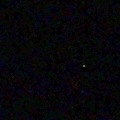
|
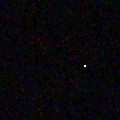
|
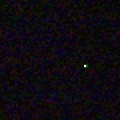
|
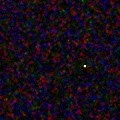
|
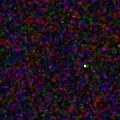
|
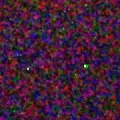
|
| ISO 80, 1s | ISO 80, 4s | ISO 80, 15s | ISO 320, 1s | ISO 320, 4s | ISO 320, 15s | |
| E-300 |

|

|

|

|

|

|
| ISO 100, 1s | ISO 100, 4s | ISO 100, 15s | ISO 400, 1s | ISO 400, 4s | ISO 400, 15s | |
|
Are we in for a surprise! The E-20, being three years older than the E-300, and having a four times smaller sensor area, exhibits fewer hot pixels, and only (if at all) slightly higher low-amplitude component. While at one and four seconds, especially at ISO 100, I think I prefer the results from E-300, at 15 seconds the E-20 is cleaner. True, the E-300 has eight megapixels, while the E-20 "only" five, but this is just a factor of 1.6; the overall photosite density in the E-20 is still 2.5 times higher per area unit (pixel pitch 1.58x smaller). All the talk about smaller sensors being more noisy may make sense, but only under the "all other things equal" assumption. And quite often, certainly in this case, the other things are not quite equal, as this small comparison clearly demonstrates. People who make lengthy spiels on how the Four Thirds system must be "inferior" to APS-sized ones because of the smaller sensor, are just wrong. If you crop an APS-sized image to the 4:3 aspect ratio (most common print formats are close to that, not the 3:2 APS aspect), the linear difference is just 12% or so, hardly noticeable. A Four-Thirds sensor may be more or less noisy than an APS-sized one, depending on technologies used, not on the insignificant difference in size. If Canon 20D has fewer hot pixels at ISO 1600 than the E-300 shows at ISO 400 (and this probably is the case), this is not because larger sensor, but because Canon did a better job, at least from this angle, with their CMOS light detector than Kodak did with their CCD used in the Olympus camera. At ISO 400 and 30 seconds (and, to a lesser extent, 15 seconds), the top left corner of my dark images exhibits a heightened, reddish background, non much unlike film being fogged. This is shown at the left picture below, being a one-to-one pixel sample. |
|
Note: these are | |
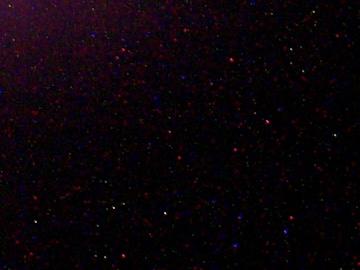
|
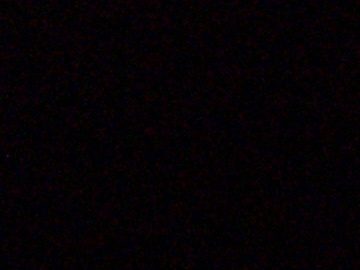
|
| ISO 400, 30 s. NR off | ISO 400, 30 s, NR on |
|
This effect, present also in cameras by other makers under similar circumstances, is mentioned somewhere in Olympus literature (if I could only remember where exactly!). I suspect it comes from thermal effects in image pickup from the sensor; due to the way in which this is done, the electron traffic is at its highest, I believe, near that corner, and this generates heat. The good news is that the effects is quite repeatable, therefore the noise reduction (dark frame subtraction) also takes care of it, as illustrated in the right sample. Oh, yes, this is yet another demonstration how the NR handles the noise and hot pixels. Summary First of all, all this discussion is relevant only for those who are shooting in really low light — using shutter speeds longer than one second, especially at ISO settings higher than 100. From the viewpoint of fixed (dark) noise, without noise reduction the E-300 is an excellent performer at ISO 100 up to four seconds or so. At longer exposures that noise rapidly increases. AT ISO 400 the noise ranges from so-so at 1 s to really prohibitive at 15 s and more. The in-camera noise reduction drastically improves the situation. At ISO 100 results become very good up to at least 30 seconds; at ISO 400 they become at least acceptable in this range. Regardless of the NR setting, the feature will be actually applied only at exposures of 4 seconds and longer. Olympus should move this limit to 2 seconds at ISO 200 and 1 second at ISO 400. Related pages
|

|
My other articles related to the |
| Home: wrotniak.net | Search this site | Change font size |
| Posted 2005/08/07; last updated 2006/02/27 | Copyright © 2005-2006 by J. Andrzej Wrotniak. |